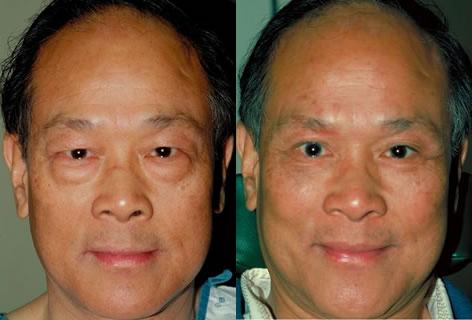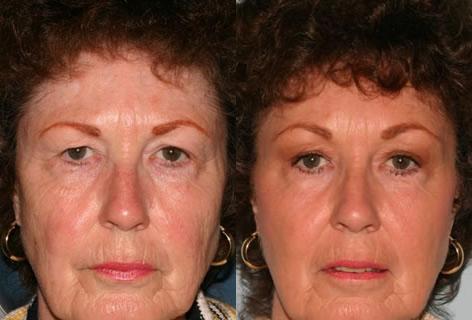The eyes are the most expressive features of the face, so patients are naturally concerned if excess skin of the lids, heavy eyebrows, and bags under the eyes prevent them from expressing the vitality they feel. For these patients, eyelid surgery known as blepharoplasty may be very helpful. If you are also unhappy with the aging changes of your eyes, the following section will help you decide if a blepharoplasty is a good procedure for you.

Types of Blepharoplasty
For the upper lids, the most common procedure involves excising a thin strip of skin and muscle. For the lower lids, the approach can involve either a skin incision immediately below the lashes (transcutaneous) or through the conjunctiva (transconjunctival). Then, excess fat is removed to reduce the eyelid bags. Occasionally, a thin strip of skin is removed from the lower lid.
Eyelid Anatomy
The anatomy of the eyelids is very complex, and differs between the upper and lower lids. Briefly, both lids are composed of outer skin, a middle layer of muscle that open the lids, and an underside called the conjuctiva which contacts the eye itself. In the lower lid, fat from the eye socket plays an important role in determining shape when too much fat is protruding into the muscle layer, then prominent bags will be seen. In the upper lids, excess muscle and skin cause problems by giving the lid a heavy, sagging look.
Suitable Patients for Blepharoplasty
Patients with excess skin, bags, or heaviness of the upper and/or lower lids make good blepharoplasty candidates. These patients will complain of looking tired or sad all the time, or looking like they are suffering from allergies. Ideal patients should also be in good health, and should be able to avoid blood thinning medications around the time of the surgery.
The Consultation
When you arrive at our San Francisco plastic surgery office for a consultation, you will be asked to complete a detailed questionnaire about your medical and surgical history. Dr. Kabaker will then take standardized photographs and examine your eyelids closely. Most importantly, you will be given ample time to describe your complaints, and to learn about your proposed procedure and how it might help you.
As mentioned elsewhere in this website, we stress patient education. So, during the consultation, you will learn a great deal about the anatomic considerations that cause your complaints, how they will be changed, what you will experience during the recovery, and your risks and alternatives to treatment. You will be given much information in writing, and we are always available for a second consultation, if you wish to review anything.
I had a facelift, eyelid surgery, and rhinoplasty about seven years ago by Dr. Kabaker, and I am very happy with the results! In fact, they are actually improving with time. Dr. Kabaker is a master of his craft, and is very devoted and caring. I received excellent personal care and attention to my special needs. The staff was very helpful. Thank you!
The Pre-operative Process
For the two weeks prior to your procedure, you should refrain from using common medications that decrease your blood’s ability to clot, including aspirin, ibuprofen, Advil, Motrin, Bufferin, Naprosyn, and large doses of vitamin E. Our doctors will give you specific instructions based on your current medications. If you have any headaches or other pain, taking acetaminophen (Tylenol) is fine. You should also avoid smoking for two weeks before your surgery. The night before your surgery, you should eat a normal dinner but avoid all oral intake after midnight. This includes drinking anything, even water.
When you schedule your blepharoplasty, you will be given a detailed set of instructions that includes much more information. A copy of these Blepharoplasty Instructions is available for you to review now.
Your Procedure
For the upper lids, an incision will be made across the top and bottom of the excess skin, and this skin will be removed. A small strip of muscle may also be excised, and then the edges will be sutured together carefully. For the bottom lids, excess fat will be removed, most commonly through incisions in the conjuntiva. It is possible that you will need a small amount of excess skin removed, in which case an incision will be made just under the lower lashes. If this skin incision is required, the scar is very well hidden by the lashes.
You will need to arrive about two hours prior to the start of your procedure. The entire procedure will take one to two hours, and you will stay in our recovery room about one hour. If you have sedation, someone should be with you to drive you home.
Anesthesia
Blepharoplasties can often be performed with just a light sedation and local anesthesia. If other procedures are being done at the same surgery, then a deeper sedation will be used.
Eyelid Surgery Recovery
There is usually very minimal discomfort after eyelid surgery. Medications will be prescribed for you to control any pain you have. You will have mild swelling and bruising, which last about seven to ten days. Sutures placed in the upper lid incision will be removed after five to seven days. Usually there are no sutures in the lower lid. You should be able to return to light activities after one week, but heavy exertion and exercise should be avoided for up to three weeks. You should be aware that redness, and even small bumps, may be evident in the upper lid incisions for many weeks. While disconcerting, these problems do resolve.
FAQs about Brow Lift
If you have further questions about blepharoplasty, check the list below to find answers. While some information presented here is also contained in the above text, these short responses should complete your introduction to facelifts and neck lifts. We also encourage you to consult with Dr. Kabaker for individualized answers to all of your questions.
Am I a good candidate for a blepharoplasty?
The best blepharoplasty patient is in good health, a non-smoker, and is able to avoid blood thinning medications for two weeks before surgery. He or she has too much fullness and heaviness of the eyelids, with or without prominent bags under the lower lids.
Can I have other procedures done at the same time as a blepharoplasty?
You can, and often patients decide to have a facelift, midface lift, or brow lift at the same time. Doing multiple procedures on the same day may lengthen the recovery time, but will allow the patient to accomplish many goals with one surgery.
Am I too young for a blepharoplasty?
There is no lower age limit. Some patients have excess upper lid skin, or prominent lower lid bags, at an early age. These conditions are often hereditary, and can be corrected with blepharoplasty surgery.
Can a brow lift correct the upper eyelids?
In some cases, elevating the brows will pull up excess upper lid skin so a blepharoplasty is not needed.
How many doctors should I consult with?
As many as you need to feel completely comfortable with the doctor you choose. Some patients are able to settle on their surgeon after only one blepharoplasty consultation, while others require several to best compare their rapport with each doctor.
Do you use computers to change my pre-operative photos?
Effective photo alteration is difficult for blepharoplasty patients. So, you should rely on your consultation alone to estimate the final result.
Do I need to see my own doctor before a blepharoplasty?
If sedation is going to be used, basic lab tests may be required, and typically patients over the age of 45 require a written clearance from their personal physicians. All specific requirements are described in the attached Blepharoplasty Instructions .
What do I need to do the day before surgery?
The day before surgery, you should eat normally but avoid excessively heavy meals, or foods that can lead to acid reflux. Prepare your affairs so that you completely relax and rest after surgery. Most importantly, do not eat or drink anything after midnight before your procedure. See the attached Blepharoplasty Instructions for all suggestions.
Where does the surgery take place?
Procedures are done at the Aesthetic Facial Plastic Surgery Our Clinic, our fully accredited surgery center.
What kind of anesthetic will be used?
If only the upper lids are involved, then a local anesthetic with light sedation will be very effective at guaranteeing patient comfort. If the lower lids need a procedure, then the sedation will probably be deeper.
How long does the procedure take?
Blepharoplasties take about one to two hours to complete.
How much pain will I have after surgery?
There is not much discomfort after blepharoplasty surgery. You may have mild soreness that is easily controlled with medications.
What are the risks of surgery?
Adverse events are rare. One possible risk is bleeding behind the eyelids. This is an extremely unlikely event, but needs immediate attention if it occurs. Such bleeding will create severe pain within the eye socket, and may change vision. If these symptoms develop, call our clinic immediately.
You may also experience a moderate burning sensation of the eye immediately after surgery. This can be controlled with eye drops, and always resolves one to two days after surgery. Changes in eyelid position, infection, and scar irregularities are other rare but possible risks.
Will I have scars?
Each upper eyelid scar is very well hidden by a prominent crease in the lid. If lower lid incisions are made through the conjunctiva, there are no visible scars. If lower lid incisions are made through the skin immediately below the lashes, the scar is well hidden by the lashes.
When will my lids look normal after surgery?
Swelling and bruising will resolve after one to two weeks, but redness of the upper lid incision may last several weeks. You may also feel small bumps under the upper incisions that can last for weeks. These are normal side effects of blepharoplasty, and will resolve.
How much time off should I take from work and exercising?
You should plan to take one to two weeks off of work, so swelling and bruising can resolve. Exercise should be avoided for about three weeks after surgery.
Do patients ever need another blepharoplasty?
The benefits of blepharoplasty will last indefinitely, and revision surgery is quite rare.

